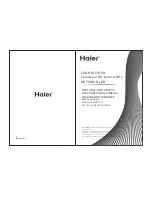
vii
ViewSonic
VT1901LED
ENGLISH
children to climb on the TV.
•
Do not install the TV in places subject to extreme
temperature, such as in direct sunlight, near a radiator, or
heating vent. If the TV is exposed to extreme temperature,
the TV may overheat and cause deformation of the enclosure
or cause malfunction.
•
Do not install the TV in a place exposed to direct air
conditioning.
•
If the TV is installed in such a location, moisture may
condense inside and may cause a malfunction.
•
Do not place the TV in hot, oily, humid or
excessively dusty places.
•
Do not install the TV where insects may
enter.
•
Do not install the TV where it may be exposed to mechanical
vibration.
•
Do not install the TV in a location where it may spear up,
such as on or behind a pillar, or where you might bump your
head on it. It may cause injury.
Preventing the TV from toppling over
To prevent the TV from toppling over, secure the TV to a wall
or stand.
Placement for watching
We suggest you to watch the TV at a distance of 3-7 times that
of the screen height, and not in excessive brightness. It is easy
to cause eye fatigue if you watch TV for too long or in a dark
room. To obtain clear picture, do not expose the screen to direct
illumination or sunlight. Use spot lighting directed down from
the ceiling if you can.
LCD SCREEN
•
Although the LCD screen is made with high precision
technology and has effective pixels of 99.99% or more, black
dots or bright points or light (red, blue, or green) may appear
constantly on the LCD screen. This is a structural property of
the LCD panel and is not a malfunction.
•
The LCD screen is made with high-precision technology. To
achieve a high level of performance and picture quality, this
TV’s backlight setting is set to maximize the brightness of
the TV. However, uneven brightness may be observed when
the LED TV is viewed in a dark environment without an input
source or a blank screen. This is a normal condition, not a
malfunction of the TV. To improve this condition, change the
Picture mode, Backlight setting, enable the Light Sensor, or
turn on the Power management.
•
Avoid exposing the LCD screen surface to direct sunlight. It
is likely to damage the LCD panel.
•
Do not push or scratch the LCD screen, or place objects on
top of the TV. The image may be uneven or the LCD panel
may be damaged.
•
If the TV is used in a cold place, a smear may occur in the
picture or the picture may become dark. It is not caused by a
failure. This condition will improve as the temperature rises.
•
When still pictures are displayed continuously, ghosting may
occur. It should disappear after a short period of time.
•
The screen and cabinet get warm when the TV is in use. This
is a normal condition.
•
Spraying insect repellent with volatile material on the screen
will cause damage.
•
Do not make prolonged contact with rubber or plastic
material.
Broken pieces
Do not throw anything at the TV.
Doing so may break the screen glass and cause
serious injury.
If the surface of the TV cracks, unplug the AC
power cord before touching the TV. Otherwise electric shock
may result.
Handling of broken glass and liquid
crystal leakage
If the LCD panel gets damaged, crystalline liquid leakage may
occur, or scattered broken glass may result. Do not touch broken
glass or crystalline liquid which is toxic, with bare hands as
cuts, poisoning or skin irritation may occur. Also do not glass
fragments or leaked crystalline liquid get into your eyes or
mouth. Should either contacted your eyes or mouth, rinse the
contacted area thoroughly with water and consult your doctor.
SERVICING
Do not attempt to repair the TV yourself,
since opening the cabinet may expose you
to dangerous voltage or other hazards. Ask
qualified service personnel to do the servicing
for your TV.
Replacement parts
When replacement parts are required, be sure the service
technician certifies in writing that he/she has used replacement
parts specified by the manufacturer that have the same
characteristics as the original parts. Unauthorized substitutions
may cause a fire, an electric shock or other hazards.
Safety check
Upon completion of repairs to the TV, ask the service
technician to perform routine safety checks (as specified by the
manufacturer) to determine that the TV is safe for operating, and
to so certify.
Ask a qualified service technician to dispose of the TV.
Summary of Contents for VS14565-1M
Page 42: ...ViewSonicTM...










































